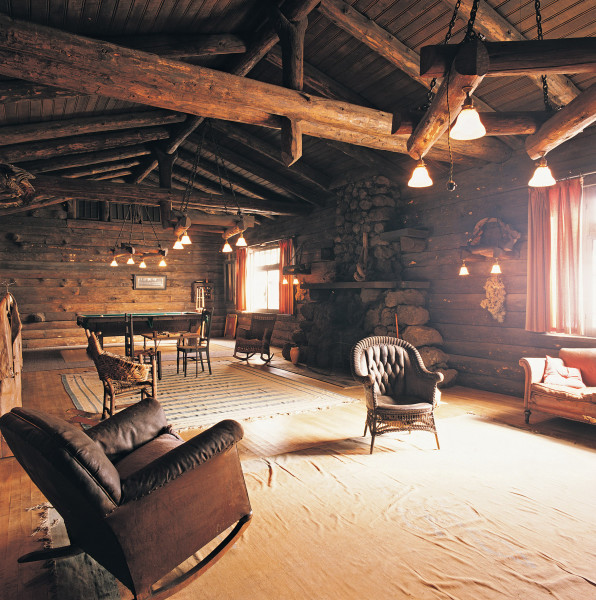At the Catskills camp built in 1910, the entire interior is sheathed in rough lumber. Bark-on split (half) logs form casings around doors, ribs in the vaulted ceiling, and “mouldings” at junctions in walls and ceilings. Smaller bark-on split logs attached vertically to lower walls create a rustic wainscot and, in some rooms, a frieze. Upper walls are sheathed in tongue-and-groove boards installed on the diagonal or vertically.
This is not, however, a “log cabin,” but rather a stone house with wood-framed interior walls clad in cedar sheathing. Because most of the wall surfaces are either flat or installed vertically, dust accumulation is less problematic than in a house with horizontal logs.
At Riordan, an Arts & Crafts Rustic house built in 1903 in Arizona, wood walls are bare under a ceiling of peeled log beams. Gross & Daley
Early on, the interior board walls had a shellac finish. The walls are occasionally cleaned, but the family believes that no subsequent finish was ever applied (except on floors). A patina that developed over 110 years is the result of the old shellac, ultraviolet light, seasonal changes, smoke from fireplaces, and so on. “The walls are dusted using feather dusters—which now are heirlooms—on extension poles,” says family friend and preservation consultant Charles Glasner. What follows is a rundown of general cleaning methods for rustic wood interiors.
- light cleaning Starting at the highest point in a room, remove cobwebs and dust using a broom or, if necessary, a barely damp mop. You can also use a shop vacuum with a brush attachment. To remove dirt, use a mild cleanser such as Murphy’s Oil Soap, rinsing afterwards. (Always test a cleaning product in an inconspicuous area.)
- removing mold/mildew Do not use bleach on wood; it will damage wood fibers and may change the color. Try a light spray of drugstore hydrogen peroxide, scrubbing with a soft brush. Now sponge distilled white vinegar, a mold killer, over affected areas.
- removing grease To remove stains and recondition wood, try a washing solution of 1 cup hot water, ¼ cup vinegar, ½ cup mineral oil (not vegetable oil), and 20 drops of lemon oil. Shake these ingredients in a screw-top bottle. Apply the homemade cleanser with a clean sponge or rag, followed by buffing with a soft, lint-free cloth. If that doesn’t do it, you may need TSP or an equivalent, diluted in warm water. Have plenty of ventilation and use rubber gloves and safety goggles. If the wood remains stained, you may need a chemical stripper or sanders. Sanding removes patina (which developed as a result of sunlight and oxidation, not only dirt), exposing the original raw color of the wood.
- maintenance Keep the wood as dust-free as possible. Damp-wipe wood monthly or twice a season. Use a mild cleanser, but never use a waxy product, which just attracts dirt.
The Magic of Shellac
Shellac was the first hard surface finish for woodwork, centuries before petroleum products and acrylics came along. Although oil varnish was available by the mid-19th century, shellac was the standard finish for Victorian and early-20th-century doors, wainscots, stair balusters, even floors. Shellac is forgiving as it readily dissolves in denatured alcohol. It can be renewed without the need for stripping; new shellac is simply applied over a clean, previously shellacked surface. Shellac also imparts an amber color that complements wood. (Today you can buy white shellac as well, a bleached version that dries clear; it’s used for light-color woods and to seal knots.)
Shellac comes from the lac bug, a tiny insect indigenous to the Far East. The bugs suck sap from trees and convert it into a hard, resinous material. The material is collected, crushed, melted down, then filtered. As it cools, liquid lac is stretched into sheets, and the dry sheets are broken into shellac flakes. Shellac is purchased as flakes, or pre-dissolved in denatured alcohol, ready for use. Shellac is organic and, both as flakes and after evaporation of the alcohol, it’s non-toxic.







